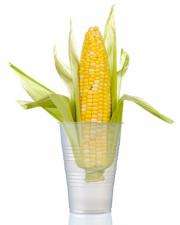One word: bioplastics

(PhysOrg.com) -- Every year, more than 250 billion pounds of plastic are produced worldwide. Much of it ends up in the world's oceans, a fact that troubles MIT biology professor Anthony Sinskey.
“Plastic does not degrade in the ocean. It just gets ground up into tiny particles,” he says. In the Pacific Ocean, a vast swath twice the size of Texas teems with tiny bits of oil-based plastic that can poison ocean life.
Sinskey can’t do much about the plastic that’s already polluting the Earth’s oceans, but he is trying to help keep the problem from getting worse. Next month, a company he founded with his former postdoc, Oliver Peoples, will open a new factory that uses MIT-patented technology to build plastic from corn. The plant aims to produce annually 110 million pounds of the new bioplastic, which biodegrades in soil or the ocean.
That’s a fraction of one percent of the United States’ overall plastic production, which totaled 101.5 billion pounds in 2008. Though it will take bioplastics a long time before they can start making a dent in that figure, the industry has significant growth potential, says Melissa Hockstad, vice president for science, technology and regulatory affairs for SPI: The Plastics Industry Trade Association.
“Bioplastics are making inroads into new markets and are an important area to watch for the future of the plastics industry,” says Hockstad, who noted that the current global market for biodegradable polymers is estimated at about 570 million pounds per year but is expected to more than double by 2012.
‘Timing is everything’
For Sinskey and Peoples, the road started 25 years ago. Peoples, who had just earned his PhD in molecular biology from the University of Aberdeen, arrived in Sinskey’s lab in 1984 and set out to sequence a bacterial gene. Today, high-speed sequencing machines could do the job in about a week. Back then, it took three years.
That gene, from the bacterium R. eutropha, turned out to code for an enzyme that allows bacteria to produce polyhydroxyalkanoate (PHA) — a naturally occurring form of polyester — starting with only sunlight, water, and a carbon source. (Bacteria normally manufacture PHA as a way to store carbon and energy.)
Sinskey and Peoples realized that if they could ramp up the bacteria’s plastic producing abilities, they could harness the organisms for industrial use. In 1994, they started a company called Metabolix and took out exclusive patents from MIT on the gene work they had done on PHA-synthesizing bacteria.
Thus began a 15-year effort to develop the technology into a robust, large-scale process, and to win support for such an approach.
On the scientific side, Peoples and the scientists at Metabolix developed a method to incorporate several genes from different bacteria into a strain of E. coli. Using this process, now called metabolic engineering, they eventually created a strain that produces PHA at levels several-fold higher than naturally occurring bacteria.
However, they had some difficulty generating support (and funding) for the idea. In the early 1990s, the public was not very receptive to the idea of alternative plastics. “Oil was $20 a barrel, and people didn’t believe in global warming,” Peoples recalls.
“Timing is everything,” says Sinskey. “There has to be a market for these materials” for them to be successful.
‘Growing interest’
The scientists believe that consumers are now ready for bioplastics. Such plastics have been commercially available for about a decade, mostly in the form of plastic cups, bottles and food packaging. Most of those products are made from a type of plastic called polylactic acid (PLA), which is also produced from corn. PLA is similar to PHA, but PHA has higher heat resistance, according to Peoples.
Possible uses for the Metabolix bioplastics include gift cards, pens, golf tees and other consumer products. Products like these, along with existing bioplastic products, tap into a “growing interest in materials that can be made from renewable resources or disposed of through practices such as composting,” says Hockstad.
The new Metabolix plant, located in Clinton, Iowa, is a joint venture with Archer Daniels Midland. Although the plant is using corn as a starting material, the process also works with other materials such as cellulose (including switchgrass), vegetable oil and cane sugar.
Turning to those agricultural starting materials could help reduce the amount of petroleum needed to manufacture traditional plastics, which currently requires about 2 million barrels of oil per day (10 percent of total U.S. daily oil consumption). “It’s important to develop alternative ways to make these chemicals,” says Peoples.
Provided by Massachusetts Institute of Technology (news : web)
















